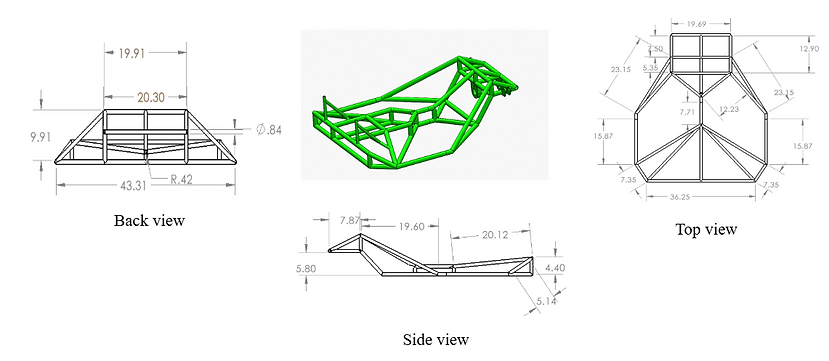VEMEC NASA HERC 2024
HUMAN EXPLORATION ROVER CHALLENGE
The Human Exploration Rover Challenge is a prestigious international competition organized by NASA, where teams design, build, and race human-powered rovers through challenging terrains that simulate extraterrestrial environments. The event promotes innovation, engineering skills, and teamwork, encouraging participants to solve real-world problems related to planetary exploration and mobility.

Our Story
On Saturday, April 20, the VEMEC U.C.B. team from the Universidad Católica Boliviana "San Pablo" was awarded the "Most Improved Performance Award" at the 30th anniversary of the prestigious NASA Human Exploration Rover Challenge (HERC) 2024, held at the Space and Rocket Center in Alabama, USA. This recognition highlights their outstanding engineering improvements to their rover during the competition. The event involved rigorous preparation over several months, including designing, building, and testing a fully mechanical lunar rover capable of navigating a challenging course with obstacles and sample collection tasks. Competing against 39 international university teams, VEMEC impressed with their adaptability, overcoming adverse weather conditions to significantly improve their rover's performance and score in the final round. Beyond the competition, the team made a remarkable impact in Bolivia, reaching over 6,000 people through STEM outreach activities, workshops, and events. This is the second recognition for the university in NASA HERC, following the 2021 "Videography Award," showcasing Bolivia’s growing excellence in science and technology on a global stage.
The NASA Human Exploration Rover Challenge serves as a catalyst for innovation, pushing participants to develop creative engineering solutions under real-world constraints. Events like this inspire groundbreaking advancements in areas such as mechanical design, material optimization, and energy efficiency. For teams like VEMEC U.C.B., the challenge fosters a culture of continuous improvement, encouraging the integration of cutting-edge technologies and methodologies. Moreover, it provides a global platform for knowledge exchange, where participants learn from diverse teams and adapt solutions to complex problems. This not only drives innovation in rover design but also builds skills and ideas that can be applied to broader fields, contributing to advancements in science, technology, and industry.






Summary of Wheel Design Features and Evolution for NASA HERC
The vehicle structure is constructed using three types of aluminum, two coated (dimensions: 1.97 x 0.079 in and 0.98 x 0.079 in) and one uncoated (dimension: 1.18 x 0.069 in). The parts are welded together using the TIG welding technique, with amperage settings between 50 and 125 amps. To maintain optimal performance, the welding machine operated on a 70% duty cycle (7 minutes of operation followed by 3 minutes of rest). The final structure's mass is 98.81 lb, demonstrating effective material optimization.
The solid axle suspension system utilizes a classic design where a single axle connects the front or rear wheels, paired with springs and shock absorbers to control vertical movement and absorb impacts. Additionally, a system of rods is integrated to limit suspension movements, stabilize the vehicle against terrain irregularities, and improve the redistribution of the Rover's center of gravity.
The drivetrain features a motion ratio of 1.9, achieved through pinions with 38 and 20 teeth. This allows the wheels to rotate 1.9 times per complete pedal revolution. With a wheel circumference of 79.16 in, the vehicle covers 150.4 in per pedal cycle, offering efficient linear travel.
-
Welding and Structure:
-
TIG welding with controlled amperage and duty cycle ensures durability.
-
Lightweight aluminum construction optimized for strength and reduced weight.
-
-
Suspension System:
-
Solid axle design with shock absorbers and springs for stability.
-
Rod system enhances terrain adaptability and center-of-gravity balance.
-
-
Drivetrain Efficiency:
-
Motion ratio of 1.9 for smooth and efficient pedaling.
-
Covers 150.4 inches per pedal cycle for optimal linear travel.
-
Summary of Wheel Design Features and Evolution for NASA HERC
-
Initial Design:
-
Focused on a pressure point approach with narrow tread and off-road patterns.
-
Created a robust and durable traction system for challenging terrains.
-
Challenges: Excessive size and material use led to inefficiencies, requiring a redesign.
-
-
Redesigned Model:
-
Inspired by mountain bike wheels, focusing on compactness, strength, and adaptability.
-
Constructed with 1060 aluminum for a balance of lightness and durability.
-
Included shock-absorbing aluminum circumferences with internal veins to prevent deformation.
-
-
Tread Patterns:
-
V-Shaped Design:
-
Maximizes traction by gripping terrain effectively.
-
Channels water to the sides, improving performance in wet conditions and preventing hydroplaning.
-
-
Lightning Design:
-
Provides greater friction for excellent grip, especially on flat terrain.
-
Increases rolling resistance but enhances stability on smooth surfaces.
-
-
-
Final Hybrid Model:
-
Combines features of the V-Shaped and Lightning designs.
-
Features a 3-ring aluminum structure for durability and impact absorption.
-
Dimensions: 25.5-inch diameter and 4-inch width for optimal stability and performance.
-
Symmetrical tread design ensures consistent traction and shock absorption.
-
-
Performance Optimizations:
-
Lightweight construction reduces bulk while maintaining strength.
-
Non-pneumatic wheels ensure reliability and resistance to impacts.
-
Detailed simulations tested performance under various loads and terrains to meet NASA HERC requirements.
-
This design delivers a versatile, high-performing wheel system tailored to handle the diverse challenges of the competition while maintaining efficiency, durability, and adaptability.